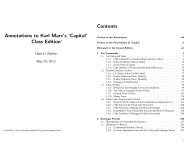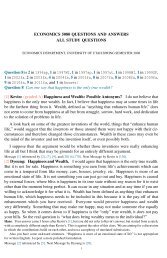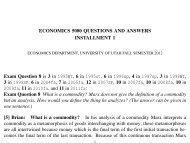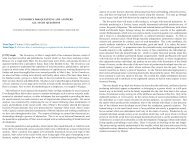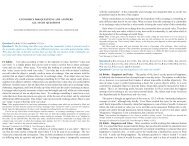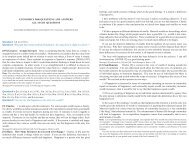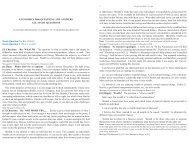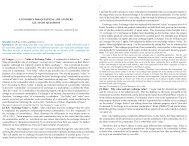Question 1 What did Marx mean with his formu - University of Utah
Question 1 What did Marx mean with his formu - University of Utah
Question 1 What did Marx mean with his formu - University of Utah
You also want an ePaper? Increase the reach of your titles
YUMPU automatically turns print PDFs into web optimized ePapers that Google loves.
U <strong>of</strong> <strong>Utah</strong> Econ 5080 2005fa 35<br />
phenomenon is appropriate in order to build a better foundation <strong>with</strong> which to build later<br />
using the more appropriate causal agents to describe what is truly going on.<br />
Hans: You seem to think the question asked why <strong>Marx</strong> is using a literary (or philosophical) text, Das Kapital, to<br />
understand the economy, instead <strong>of</strong> just explaining what the people in a capitalist economy are doing.<br />
T<strong>his</strong> is not what the question asked, and I am not even sure if t<strong>his</strong> was indeed your interpretation <strong>of</strong> the question,<br />
but I would like to just make two points regarding your answer as I understand it:<br />
1. The behavior <strong>of</strong> the individuals cannot by itself explain capitalism, because t<strong>his</strong> behavior does not explain<br />
the conditions under which people act.<br />
2. The philosophical-sounding arguments at the beginning <strong>of</strong> Das Kapital are not preliminaries setting the stage<br />
for the real explanation, but they are <strong>Marx</strong>’s attempts to infer the conditions <strong>of</strong> people’s actions from these actions<br />
themselves.<br />
Next Message by Xerho is [216].<br />
<strong>Question</strong> 62 is 31 in 1995WI, 40 in 1996ut, 38 in 1997ut, 55 in 2002fa, 57 in 2003fa, 73<br />
in 2007SP, 73 in 2007fa, 74 in 2008fa, 77 in 2010fa, and 90 in 2011fa:<br />
<strong>Question</strong> 62 <strong>Marx</strong> argues that commodities are exchangeable only because they contain<br />
some common substance. Bailey denies t<strong>his</strong>. He compares the exchange-value <strong>of</strong> commodities<br />
<strong>with</strong> the distance between points, which is not based on a commonality between the two<br />
points but is purely relative: “As we cannot speak <strong>of</strong> the distance <strong>of</strong> any object <strong>with</strong>out<br />
implying some other object, between which and the former t<strong>his</strong> relation exists, so we cannot<br />
speak <strong>of</strong> the value <strong>of</strong> a commodity but in reference to another commodity compared <strong>with</strong> it.<br />
A thing cannot be valuable in itself <strong>with</strong>out reference to another thing” . Comment.<br />
[83] Thugtorious: graded A Bailey’s Critique <strong>of</strong> <strong>Marx</strong>. In deriving the exchange relationship<br />
between two commodities, <strong>Marx</strong> argues that there is a common substance <strong>with</strong>in<br />
the commodities that makes them exchangeable. We find out later that t<strong>his</strong> “element” is<br />
abstract human labor. However, Bailey argues that the exchangeability <strong>of</strong> two commodities<br />
has nothing to do <strong>with</strong> a commonality between the two commodities, but can be likened to<br />
the distance between two points, which is purely relative. Unfortunately, the distance between<br />
two points remains completely relative and has not applicability to market operations<br />
or exchange unless there is a denomination or mechanism at which the two “points” can be<br />
related. Let me explain:<br />
There is two ways to look at t<strong>his</strong> situation. The first example elaborates on Bailey’s geometric<br />
example about two points. Bailey’s focus is on the line connecting the two points,<br />
but if you do not define a mechanism <strong>of</strong> measurement to evaluate the length <strong>of</strong> such a line<br />
then the line itself is irrelevant. For example, if Bailey chose to use “feet” as the basis <strong>of</strong><br />
comparison, then the distance would be X amount <strong>of</strong> feet showing a quantified relationship<br />
between the two points. T<strong>his</strong> is what abstract human labor is equated to: defining the “distance”<br />
between two commodities in the market place. <strong>Marx</strong> chose labor as <strong>his</strong> proverbial<br />
“yard stick.” Without such a yard stick, the two points may be connected, but there is no way<br />
to tell at what extent they are connected.<br />
The second example is arithmetic in nature. If you want to compare two fractions while<br />
cooking because you are increasing the size <strong>of</strong> your recipe, then you have to make the<br />
denominators <strong>of</strong> both fractions equal. Much the same thing is going on in transactions in<br />
the market. When comparing two commodities for exchange in the market, the common<br />
36 2005fa Econ 5080 U <strong>of</strong> <strong>Utah</strong><br />
denominator is abstract human labor. The denominator is just like the “yard stick” in the<br />
previous example: <strong>with</strong>out it, there is no relevant relationship between the two commodities.<br />
Overall, I think Bailey missed a large part <strong>of</strong> <strong>Marx</strong>’s argument: on the surface <strong>of</strong> the<br />
exchange, the decided values <strong>of</strong> each commodity may appear purely relative. However, if<br />
you dig deeper into each commodity, down into the mode <strong>of</strong> production, you find that there<br />
is a common element: abstract human labor. Bailey <strong>did</strong> not go deep enough into <strong>Marx</strong>’s<br />
argument but decided to take the contradiction <strong>of</strong> exchange as a given and move on <strong>with</strong> the<br />
analysis <strong>with</strong>out resolving the contradiction.<br />
Message [83] referenced by [106]. Next Message by Thugtorious is [100].<br />
[106] Hans: How distant is a relative? Oops, I <strong>mean</strong>t, how relative is a distance? In a<br />
manuscript discussing the above quote from Bailey, <strong>Marx</strong> argues that the distance between<br />
two points is not as relative as it may seem. He brings two considerations. Both points are<br />
written by <strong>Marx</strong> in English, although most <strong>of</strong> the manuscript is German. <strong>Marx</strong> was probably<br />
sitting in the British Museum in London while writing t<strong>his</strong>. The next two paragraphs are<br />
literal quotes from <strong>Marx</strong>:<br />
(1) When a thing is distant from another, the distance is in fact a relation<br />
between the one thing and the other; but at the same time the distance is<br />
something different from t<strong>his</strong> relation between the two things. It is a dimension<br />
<strong>of</strong> the space, it is some length which may as well express the<br />
distance <strong>of</strong> two other things besides those compared.<br />
(2) If we speak <strong>of</strong> the distance as a relation between two things, we suppose<br />
something “intrinsic,” some “property” <strong>of</strong> the things themselves, which enables<br />
them to be distant from each other. <strong>What</strong> is the distance between the<br />
syllable A and a table? The question would be nonsensical. In speaking<br />
<strong>of</strong> the distance <strong>of</strong> two things, we speak <strong>of</strong> their difference in space. Thus<br />
we suppose both <strong>of</strong> them to be contained in the space, to be points <strong>of</strong> the<br />
space. Thus we equalize them as being both existences <strong>of</strong> the space, and<br />
only after having them equalized sub specie spatii we distinguish them as<br />
different points <strong>of</strong> space. To belong to space is their unity.<br />
These are interesting arguments worth pondering. Should question 62 show up in the<br />
exam, t<strong>his</strong> is what you ought to remember.<br />
Here are some additional points which are not as important as the above food for thought:<br />
(a) Even in t<strong>his</strong> example <strong>of</strong> points in space, the relation between the points is only possible<br />
because they have something in common. T<strong>his</strong> <strong>of</strong> course resonates <strong>with</strong> <strong>Marx</strong>’s argument<br />
that also the exchange relation between commodities is based on a commonality in these<br />
commodities.<br />
(b) How does all t<strong>his</strong> relate to Thugtorious’s [83]? I will not go into the details but give<br />
just one general observation. <strong>Marx</strong> is always very careful to investigate the qualities <strong>of</strong><br />
things before looking at their quantities. Modern sciences have forgotten how to deal <strong>with</strong><br />
qualities, everything has been quantified. Thugtorious in <strong>his</strong> argument also gives too much<br />
importance to the quantities <strong>of</strong> things.



